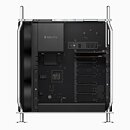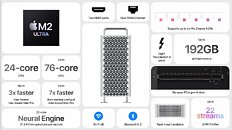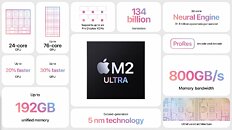Apple today at WWDC announced a slew of new products, but one major one that the industry has been waiting for is the Apple silicon update to the Mac Pro. The new Mac Pro features the similarly new M2 Ultra which combines two M2 Max SoCs together via their UltraFusion interconnect, similar to M1 Ultra. M2 Ultra remains on TSMC's 5 nm and features 24-cores as well as configuration options for up to a 76 FSTP GPU slice and 192 GB of unified RAM. Apple is making bold claims about M2 Ultra's performance in comparison to the outgoing Intel Mac Pro, claiming it to be 3x faster than the fastest Intel configuration. The new Mac Pro doesn't change the chassis or aesthetic of the 2019 Intel based Mac Pro, which means that it retains a much wider array of expansion options in both tower or rack mount configurations. Expansion options include eight Thunderbolt 4 ports, two USB 3.2 Type A, two HDMI, dual 10GbE ports, and a 3.5 mm audio jack on the rear. Inside the mostly empty chassis there are six open PCI-E Gen 4 x16 slots for expansion, however Apple will likely still not support third-party graphics options on Apple silicon machines so these slots are for predominantly for accelerator, capture, network, broadcast, and storage expansion boards. However, what appears to be a 12VHPWR sits alongside a pair of SATA expansion ports above the PCI-E on the motherboard. The 2023 M2 Mac Pro will start at $6999 USD and is available starting June 13th.




View at TechPowerUp Main Site




View at TechPowerUp Main Site









